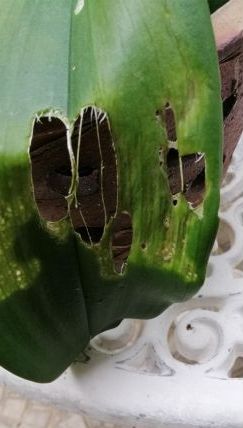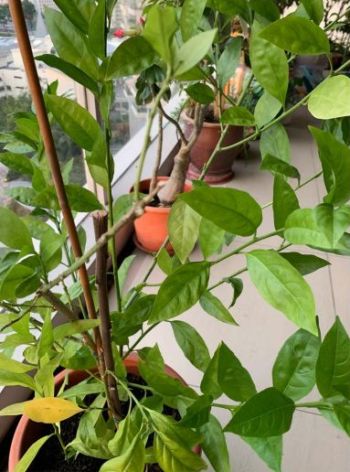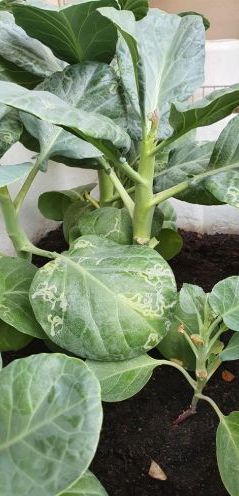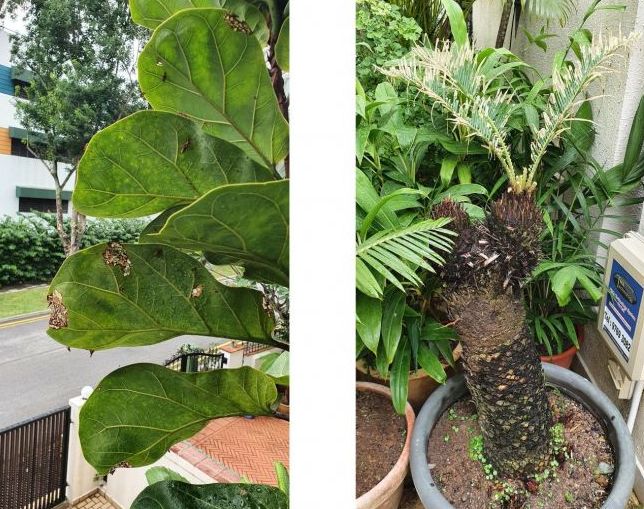Gardening FAQ #23 – What You Need To Know
In this article, we share how to handle snails, slugs, leaf miners, larvae, caterpillars and much more. Let’s go through the common gardening FAQ, problems and solutions you need when growing your plants either indoor and outdoor.
LEAVES OF ORCHID EATEN BY SNAILS OR SLUGS – a common question in gardening FAQ
 My orchids were growing well, but the leaves were attacked by a pest. The pots are placed on a high metal rack and get direct sun for half a day. There are squirrels and snails in my garden.
My orchids were growing well, but the leaves were attacked by a pest. The pots are placed on a high metal rack and get direct sun for half a day. There are squirrels and snails in my garden.
It appears that your orchid leaves have been eaten by snails or slugs.
You may want to check the potting media for the pests as they tend to hide in dark and moist places in the day. Hanging up your potted orchids can deter access by these pests.
You can also check for their presence at night, especially after wet weather, and remove the pests seen on your plant.
Putting snail and slug poison bait pellets may help reduce their population, but keep them out of reach of young children and pets.
Slugs and Snails cause a lot of damage to gardens by chewing on edible leaves, vegetables and fruit. In the video below, it shows you 5 easy ways to control snails and slugs in your garden. The 5 ways are:
- Water your plants early in the day
- Setup beer trap to catch snails and slug
- Hand-picking them off
- Use snail and slug bait (iron phosphate)
- Use copper strips
SHRUB NEEDS MORE SUNLIGHT TO FLOWER
 What is the name of this plant? I was told it produces fragrant flowers, but there have been no blooms even after I apply flowering fertilisers. The leaves also turn yellow and drop off sometimes. Why is that happening?
What is the name of this plant? I was told it produces fragrant flowers, but there have been no blooms even after I apply flowering fertilisers. The leaves also turn yellow and drop off sometimes. Why is that happening?
From the leaves, it appears that your plant is a species of Cestrum. Flowers are needed for a more definitive identification of the species.
The lack of flowers could be due to a lack of sunlight. Most flowering shrubs require at least six hours of direct sunlight to thrive and produce blooms. Or you may want to put this under a grow light first to nurse it back to health before putting it out to the final location. You can read up my post on growing lights fixture where I show you the top 4 things you need to know.
The yellowing and dropping of leaves, especially those found on the lower portion of the plant, is an indication of a lack of water.
Your plant may be pot-bound – a situation where the roots have filled the pot. It may have to be moved to a larger pot, which can hold more soil and hence moisture for the plant.
If you want to do such transplant easily, you should explore using grow bags. See my other post on grow bags.
KAILAN INFESTED WITH LEAF MINERS
 My kailan plants were growing well, albeit slowly. I transplanted the seedlings in early June and the leaves have not grown to full size yet. But recently, yellow streaks started appearing on the leaves. The new leaves also looked dried out. I check the soil’s moisture and water the plants regularly. What could be the problem?
My kailan plants were growing well, albeit slowly. I transplanted the seedlings in early June and the leaves have not grown to full size yet. But recently, yellow streaks started appearing on the leaves. The new leaves also looked dried out. I check the soil’s moisture and water the plants regularly. What could be the problem?
Your plants are infested with the larvae of leaf miners. The adults are small flying insects that lay eggs on leaves. Larvae that hatch burrow into leaf tissues, leading to the white tracks seen on the leaves.
Leaf miners can be difficult to control. You may want to invest in a white fine netting that prevents the egg-laying adults from reaching the plants.
Organic pesticides like neem oil are reported to have some repellent effects.
Another method is you can try using sticky traps.
As for the slow growth of your plants, you have to feed them as they are in the active growing stage and require nutrients. Ensure that the plants are receiving enough direct sunlight as overcrowding and shading will slow the growth rate.
Smaller plants can be picked first to give more space for the remaining plants to reach full size.
FIDDLE-LEAF FIG AND SAGO PALM INFESTED WITH LARVAE AND CATERPILLARS
Every time new branches grow on my palm, they would die quickly with some infestation. Why is this so? The leaves of the ficus plant on my balcony are also infected and are drying out from the inside. How can I fix the problems?

Your fiddle-leaf fig (Photo 1) is infested by bagworms, which are larvae of moths that cover themselves within a case made from various materials.
The young leaves of the sago palm (Cycas revoluta, Photo 2) are being eaten by caterpillars of the cycad blue butterfly. Adult butterflies are attracted to the young emerging fronds and lay their eggs there.
You can spray a pesticide such as spinosad and abamectin to eradicate the leaf-consuming larvae. They are very effective as they are absorbed into the leaf tissues after they have been applied, so they will not be washed away by the rain.